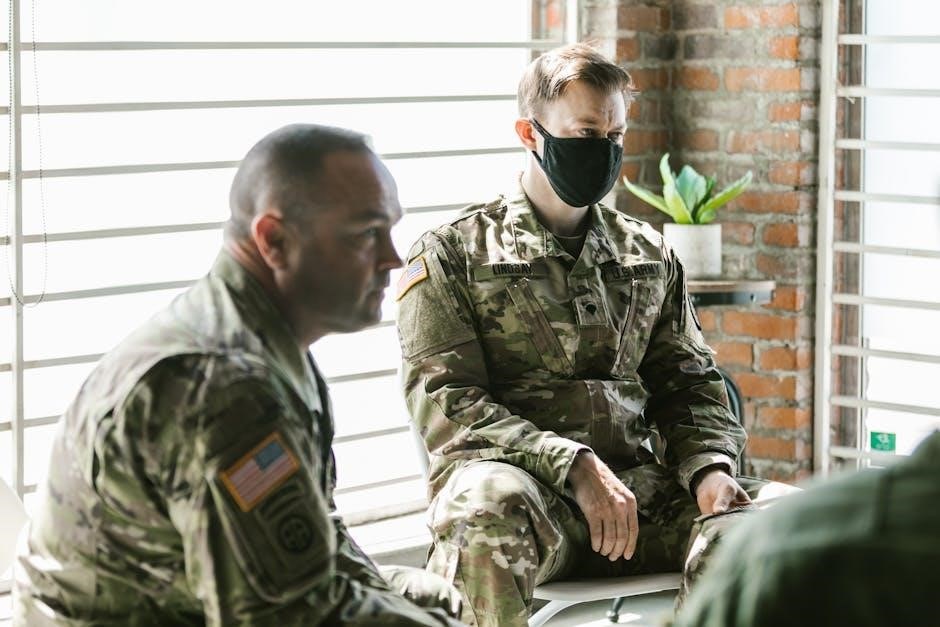healing trauma worksheets pdf

Trauma and PTSD are deeply impactful mental health conditions, often triggered by distressing events. Understanding symptoms and effects is crucial for effective healing and recovery.
1.1 What is Trauma?
Trauma refers to emotional, psychological, or physical distress caused by experiencing or witnessing distressing events. It can result in long-term effects on mental health, impacting how individuals process emotions and react to triggers. Trauma responses vary, with common reactions including fight, flight, freeze, or fawn. These reactions are survival mechanisms, but prolonged trauma can lead to conditions like PTSD. Understanding trauma is essential for providing effective support and fostering healing. Recognizing the signs and effects of trauma is the first step toward recovery and emotional well-being.
1.2 Understanding PTSD and Its Symptoms
Post-Traumatic Stress Disorder (PTSD) is a mental health condition triggered by experiencing or witnessing traumatic events. Common symptoms include flashbacks, nightmares, severe anxiety, and uncontrollable thoughts about the event. Individuals may also exhibit avoidance behaviors, avoiding reminders of the trauma, and experience emotional numbing or heightened arousal. These symptoms can significantly impact daily life and relationships. Understanding PTSD is crucial for effective diagnosis and treatment, allowing individuals to manage their symptoms and work toward recovery. Recognizing the signs of PTSD is the first step in providing support and facilitating healing.
1.3 The Importance of Healing Trauma
Healing trauma is essential for restoring emotional and mental well-being. Left unaddressed, trauma can lead to long-term mental health issues, strained relationships, and impaired daily functioning. Addressing trauma through structured approaches, such as worksheets and exercises, helps individuals process their experiences, manage symptoms, and rebuild resilience. Healing fosters personal growth, improves emotional regulation, and enhances overall quality of life. It also breaks the cycle of negative thought patterns and behaviors, allowing individuals to reclaim control over their lives and move forward with hope and confidence.

Benefits of Using Worksheets for Trauma Healing
Trauma healing worksheets provide a structured and accessible way to process experiences, offering practical tools for emotional regulation, self-care, and recovery. They empower individuals to manage symptoms effectively.
2.1 Structured Approach to Healing
Trauma healing worksheets offer a clear, organized path for recovery, helping individuals process emotions systematically. They provide step-by-step exercises, fostering accountability and consistency. By breaking down complex healing processes into manageable tasks, worksheets enable users to focus on specific aspects of their trauma. This structured method reduces overwhelm, allowing for gradual progress. It also helps users identify patterns, gain insights, and develop coping strategies. The clarity and direction of worksheets make them invaluable tools for navigating the often chaotic journey of trauma recovery, ensuring a purposeful and effective healing experience.
2.2 Practical Exercises for Emotional Regulation
Trauma healing worksheets often include practical exercises designed to help individuals manage and regulate their emotions. These exercises, such as breathing techniques, journaling, and emotional awareness prompts, provide actionable steps to calm the nervous system and process difficult feelings. By practicing these exercises regularly, users can gain better control over their emotional responses, reducing the intensity of traumatic reactions. These tools empower individuals to develop resilience and improve their ability to navigate challenging emotions, making them an essential part of the healing journey.
2.4 Accessibility and Convenience of PDF Formats
Trauma healing worksheets in PDF format offer unparalleled accessibility and convenience. They can be easily downloaded, stored, and accessed on various devices, making them portable for use anywhere. PDFs are compatible with multiple platforms, ensuring users can work on them without needing specialized software. Additionally, they can be printed, allowing individuals to complete exercises offline. This flexibility makes PDF worksheets a practical choice for anyone seeking to heal from trauma, regardless of their location or technological setup. Their convenience fosters consistency in the healing process.
Key Components of Trauma Worksheets
Trauma worksheets include grounding techniques, emotional awareness exercises, and self-care plans. These elements help individuals process trauma effectively, promoting healing and emotional stability.
3.1 Grounding Techniques
Grounding techniques are essential in trauma worksheets, helping individuals reconnect with the present moment. These exercises, such as deep breathing, sensory focus, or the “5-4-3-2-1” method, reduce dissociation and anxiety. By engaging the senses, grounding techniques create a sense of safety and stability, allowing individuals to process trauma without feeling overwhelmed. These practices are often the first step in trauma recovery, providing a foundation for further healing. Regular use of grounding exercises in worksheets can enhance emotional regulation and improve overall well-being for those navigating traumatic experiences.
3.2 Emotional Awareness and Expression
Emotional awareness and expression are critical components of trauma healing worksheets, enabling individuals to identify and process their feelings. Worksheets often include exercises like journaling, emotional labeling, or feeling charts to help users recognize patterns and intensity of emotions. Expressing emotions safely allows individuals to release trauma-related feelings, reducing emotional overwhelm. These exercises foster self-understanding and empathy, creating a foundation for meaningful healing. By encouraging honest expression, worksheets empower individuals to confront and manage emotions effectively, promoting long-term emotional resilience and recovery from traumatic experiences.
3.3 Self-Care and Safety Planning
Self-care and safety planning are essential for trauma recovery, helping individuals establish routines and strategies to maintain emotional and physical well-being. Worksheets often include activities like creating self-care checklists, identifying safe spaces, and developing crisis plans. These tools empower users to prioritize their needs, build resilience, and feel secure. By focusing on practical steps, worksheets help individuals regain control over their lives, fostering a sense of stability and confidence. Regular practice of these strategies promotes long-term healing and reduces the risk of emotional overwhelm during the recovery process.
Popular Types of Trauma Worksheets
Trauma worksheets include CBT, DBT, and mindfulness exercises, each targeting specific healing needs. These tools offer structured approaches to managing symptoms and promoting emotional recovery effectively.
4.1 Cognitive-Behavioral Therapy (CBT) Worksheets
CBT worksheets are designed to help individuals identify and challenge negative thought patterns linked to trauma. These tools focus on restructuring harmful beliefs and behaviors, promoting emotional regulation. By addressing cognitive distortions, users can develop healthier coping mechanisms and improve their response to triggers. Practical exercises include thought records, behavior activation plans, and exposure tasks. CBT worksheets are widely used due to their evidence-based approach and effectiveness in managing PTSD symptoms. They are often available in PDF formats, making them accessible for self-guided healing or therapist-assisted programs. Regular use can lead to significant improvements in mental health and trauma recovery.
4.2 Dialectical Behavior Therapy (DBT) Worksheets
DBT worksheets focus on teaching emotional regulation, distress tolerance, and interpersonal skills, essential for managing trauma-related emotions. These tools help users identify triggers and develop coping strategies to reduce self-destructive behaviors. Practical exercises include emotional checklists, chain analyses, and skill assessments. DBT worksheets are particularly effective for addressing intense emotions and impulse control, often seen in trauma survivors. They encourage mindfulness and self-awareness, promoting long-term emotional stability. Available in PDF formats, these worksheets are versatile for both individual use and therapeutic settings, offering a structured path toward healing and emotional resilience.
4.3 Mindfulness and Relaxation Exercises
Mindfulness and relaxation exercises are powerful tools for trauma healing, helping individuals manage stress and anxiety. These exercises, often included in PDF worksheets, guide users through techniques like deep breathing, body scans, and guided meditations. By fostering present-moment awareness, mindfulness reduces the impact of traumatic memories. Relaxation exercises promote emotional calm and reduce hyperarousal, common in trauma survivors. These worksheets provide structured practices that can be done anywhere, offering a sense of control and empowerment. Regular use enhances emotional resilience, aiding in the journey toward healing and long-term well-being. They complement other therapies, creating a holistic approach to trauma recovery.

Trauma Worksheets for Specific Populations
Trauma worksheets are tailored for different age groups and specific needs, ensuring effective and relevant healing tools for diverse populations. These resources address unique challenges, fostering recovery.
5.1 Worksheets for Children and Adolescents
Trauma worksheets for children and adolescents are designed to be age-appropriate and engaging, helping young individuals process their experiences in a safe and structured manner. These resources often incorporate visual activities, such as drawing or coloring, to help kids express emotions they may struggle to articulate. Worksheets may include exercises for identifying feelings, grounding techniques, and creating safety plans. They also aim to foster emotional regulation and resilience, providing a foundation for long-term healing. Caregivers and therapists can use these tools to guide children through their trauma journey, making recovery more accessible and effective.
5;2 Worksheets for Adults and Seniors
Worksheets for adults and seniors are tailored to address complex life experiences and long-held trauma patterns. These resources often focus on reflection, self-awareness, and practical strategies for emotional management. Cognitive-behavioral exercises help identify and challenge negative thought patterns, while mindfulness practices promote relaxation and grounding. Seniors may benefit from worksheets that incorporate life review techniques, fostering a sense of closure and meaning. These tools empower adults to take charge of their healing journey, offering a structured yet flexible approach to processing trauma and rebuilding resilience at any stage of life.
5.3 Worksheets for Trauma Bonding and Relationships
Worksheets for trauma bonding and relationships focus on understanding and breaking harmful connection patterns. These tools help individuals identify manipulative dynamics and rebuild trust. Exercises may include recognizing emotional manipulation, setting boundaries, and fostering healthy communication. They empower individuals to break free from toxic cycles and develop resilient, balanced relationships. These worksheets are particularly useful for those healing from abusive or controlling partnerships, promoting emotional freedom and healthier relational habits.

How to Use Trauma Worksheets Effectively
Using trauma worksheets effectively involves consistency, a safe environment, and professional guidance. Start with small steps, prioritize emotional comfort, and review progress regularly for optimal healing outcomes.
6.1 Guidance from Mental Health Professionals
Guidance from mental health professionals is crucial for effectively using trauma worksheets. Therapists can tailor worksheets to individual needs, ensuring they address specific trauma experiences. They provide support and clarification, helping clients understand and process emotions. Professionals also offer feedback, reinforcing progress and addressing challenges. Their expertise ensures worksheets are used safely and effectively, promoting healing without overwhelming the individual. Regular sessions with a therapist can enhance the benefits of worksheets, fostering a structured and supportive environment for recovery.
6.2 Consistency and Patience in Practice
Consistency and patience are essential when using trauma worksheets for healing. Regular practice helps reinforce new coping strategies and emotional regulation techniques. Healing from trauma is a gradual process, and worksheets are most effective when used patiently over time. Consistency builds resilience and fosters a sense of control, while patience allows individuals to navigate challenging emotions without feeling overwhelmed. Over time, these practices lead to meaningful progress, even if growth feels slow. Staying committed ensures long-term benefits and sustained emotional well-being.
6.3 Combining Worksheets with Therapy Techniques
Combining trauma worksheets with established therapy techniques enhances the healing process. Worksheets complement methods like CBT, DBT, or mindfulness by providing structured exercises to apply therapeutic principles. For example, CBT worksheets can be used alongside cognitive restructuring, while DBT exercises can reinforce emotional regulation skills. Mindfulness practices, such as deep breathing or grounding, can be integrated with worksheet activities to deepen relaxation and focus. This combination allows individuals to explore their emotions, challenge negative thoughts, and develop coping strategies in a comprehensive and holistic way, guided by a therapist or through self-directed practice.

Free and Paid Resources for Trauma Worksheets
Explore free printable PDFs, therapist-approved workbooks, and online platforms offering diverse trauma healing tools tailored to individual needs and therapeutic approaches.
7.1 Free Printable PDF Worksheets
Free printable PDF worksheets are widely available online, offering accessible tools for trauma healing. Websites like PsychologyTools, Therapist Aid, and Trauma Recovery provide diverse exercises. These worksheets cover grounding techniques, emotional regulation, and self-care strategies. Many are designed for specific needs, such as PTSD, anxiety, or childhood trauma. They are cost-effective and easily downloadable, making them ideal for individuals seeking self-help resources or therapists looking for supplemental materials. While free options are abundant, they are best used under professional guidance to ensure effectiveness and proper implementation in the healing process.
7.2 Therapist-Approved Paid Workbooks
Therapist-approved paid workbooks offer comprehensive, evidence-based tools for trauma healing. Designed by mental health professionals, these workbooks provide structured exercises tailored to specific trauma types. They often include detailed instructions, practical strategies, and progress-tracking features. Popular options are available on platforms like Amazon or specialized therapy websites. These workbooks are ideal for those seeking in-depth guidance and are frequently recommended by therapists for their effectiveness. While they require a purchase, they offer high-quality, professional content that supports long-term healing and personal growth.
7.3 Online Platforms and Communities
Online platforms and communities provide valuable resources for trauma healing, offering accessible and engaging tools. Many websites host downloadable PDF worksheets, guided exercises, and forums where individuals can share experiences. These platforms often feature expert-led webinars, supportive groups, and personalized tracking tools. They foster connection and understanding among users, reducing feelings of isolation. Paid subscriptions may unlock premium content, but free resources are also widely available. These platforms empower individuals to heal at their own pace, supported by a global community dedicated to trauma recovery and mental well-being.

Case Studies and Success Stories
Case studies highlight individuals overcoming trauma through worksheets, showing measurable progress and emotional healing. Success stories demonstrate the effectiveness of structured exercises in trauma recovery.
8.1 Real-Life Examples of Healing Through Worksheets
Real-life examples demonstrate how trauma worksheets have empowered individuals to process their experiences. For instance, a survivor of childhood trauma used grounding techniques to manage flashbacks, while a veteran applied emotional expression exercises to reduce PTSD symptoms. These tools, often in PDF formats, provided structured paths to healing. Consistent use of worksheets helped individuals regain control over their emotions and rebuild their sense of safety. Such examples highlight the practical and transformative impact of worksheets in trauma recovery journeys, offering hope and tangible results for those seeking healing.
8.2 Testimonials from Therapists and Clients
Therapists and clients alike praise the effectiveness of trauma worksheets in facilitating healing. One therapist shared, “These tools have been invaluable in helping clients articulate emotions and process trauma.” A client noted, “The structured exercises gave me clarity and empowerment, making my healing journey manageable.” Many highlight how worksheets complement therapy, offering a tangible way to track progress. Testimonials frequently emphasize the sense of control and confidence gained through consistent use of these resources, underscoring their role in fostering meaningful recovery and emotional growth.
8.3 Measurable Outcomes and Progress Tracking
Trauma worksheets often include tools for tracking progress, allowing individuals to measure their healing journey. Standardized assessments and self-reporting scales help quantify improvements in emotional regulation and symptom reduction. Many worksheets incorporate checklists, journal prompts, and rating systems to monitor growth over time. This structured approach provides tangible evidence of progress, fostering motivation and accountability. By regularly reviewing completed exercises, individuals can identify patterns, celebrate milestones, and address areas needing further attention. This data-driven method enhances the effectiveness of therapy and empowers individuals to take an active role in their recovery process.

Advanced Techniques for Trauma Healing
Advanced methods like prolonged exposure, schema therapy, and art therapy integrate with worksheets to deepen healing. These techniques address complex trauma, promoting lasting recovery and emotional resilience.
9.1 Prolonged Exposure Therapy
Prolonged exposure therapy is an evidence-based approach that helps individuals confront and process traumatic memories. By systematically revisiting traumatic experiences in a controlled environment, individuals reduce fear and avoidance behaviors. Worksheets can complement this therapy by providing structured tools for recording triggers, emotions, and coping strategies. They also offer a way to track progress and reinforce new perspectives. This method, combined with worksheets, fosters emotional resilience and long-term healing, making it a powerful tool in trauma recovery programs.
9.2 Schema Therapy for Trauma
Schema therapy addresses deep-seated patterns, or “schemas,” formed due to trauma, which drive negative beliefs and behaviors. Worksheets can help individuals identify and challenge these schemas, promoting emotional regulation and self-compassion. By mapping triggers and emotions, individuals can develop healthier coping strategies. This approach encourages redefining one’s identity and rebuilding resilience, making worksheets a valuable tool in schema therapy for trauma recovery. They provide structure for reflection and growth, aiding in the transformation of harmful patterns into adaptive responses. This method fosters long-term emotional well-being and empowerment.
9.3 Art Therapy and Creative Expression
Art therapy combines creativity with emotional healing, offering a non-verbal outlet for processing trauma. Worksheets incorporating art exercises, such as drawing or painting, help individuals express feelings they struggle to articulate. Through creative expression, participants can explore and reinterpret traumatic experiences, fostering self-discovery and emotional release. These activities reduce overwhelm and promote a sense of control, making them a powerful complement to traditional therapies. Art therapy worksheets empower individuals to transform pain into meaningful expression, aiding in trauma recovery and personal growth. This approach is particularly effective for those who find verbal communication challenging.

The Role of Self-Care in Trauma Recovery
Sustainable self-care rituals reduce stress and foster emotional resilience, creating a foundation for healing. Prioritizing well-being enhances daily functioning and supports long-term trauma recovery effectively.
10.1 Daily Self-Care Practices
Daily self-care practices are essential for trauma recovery, fostering stability and emotional well-being. Activities like mindfulness, journaling, and grounding exercises help regulate emotions and reduce stress. Physical activities, such as walking or yoga, promote endorphins, enhancing mood. Healthy eating, hydration, and adequate sleep are vital for physical and mental healing. Worksheets can guide these practices, offering structured routines and reflection opportunities. Consistency in self-care builds resilience, empowering individuals to navigate triggers and setbacks more effectively, while nurturing a compassionate relationship with oneself.
10.2 Building a Support Network
Building a support network is crucial for trauma recovery, as it provides emotional and practical assistance. Surrounding yourself with understanding friends, family, or support groups can reduce feelings of isolation. Professional guidance from therapists or counselors also plays a key role. Worksheets often include exercises to identify and communicate with support systems, fostering healthier relationships. Sharing progress with trusted individuals can enhance accountability and encouragement. A strong network helps individuals feel safe and validated, which is vital for healing and rebuilding trust after trauma.
10.3 Physical Health and Trauma Recovery
Physical health plays a vital role in trauma recovery, as trauma often manifests in the body. Chronic stress from unresolved trauma can lead to issues like pain, fatigue, or weakened immunity. Worksheets often emphasize the importance of physical self-care, such as exercise, nutrition, and sleep. Activities like yoga or deep breathing exercises can reduce tension and restore balance. Addressing physical health alongside emotional healing creates a holistic approach to recovery, helping individuals regain control over their bodies and improve overall well-being.

Overcoming Challenges in Trauma Healing
Overcoming challenges in trauma healing involves navigating obstacles like triggers, emotional overwhelm, and self-doubt. Worksheets provide structured tools to address these issues, fostering resilience and progress.
11.1 Managing Triggers and Setbacks
Managing triggers and setbacks is a critical part of trauma healing. Worksheets can help identify patterns and develop coping strategies, reducing emotional overwhelm. By practicing grounding techniques and self-compassion, individuals can better navigate challenging moments; Tracking progress in worksheets fosters accountability and resilience. Over time, these tools empower individuals to anticipate triggers and respond with healthier mechanisms, minimizing setbacks and promoting sustained healing. Regular use of trauma worksheets can enhance emotional regulation and improve overall well-being during the recovery journey.
11.2 Breaking the Cycle of Shame and Guilt
Breaking the cycle of shame and guilt is essential for trauma healing. Worksheets help individuals identify and challenge negative self-perceptions rooted in trauma. Through journaling and cognitive restructuring exercises, individuals can reframe harmful beliefs and cultivate self-compassion. These tools also encourage accountability without self-blame, fostering emotional release and growth. By addressing shame and guilt directly, worksheets empower individuals to move beyond self-criticism and embrace a more balanced, compassionate perspective, aiding in lasting trauma recovery and emotional well-being.
11.3 Building Resilience and Hope
Building resilience and hope is a cornerstone of trauma recovery. Worksheets designed for this purpose often include exercises that foster coping skills, positive affirmations, and future-oriented goal setting. By engaging with these tools, individuals can gradually shift their focus from trauma to possibilities, cultivating hope and strength. Activities like gratitude journaling and strength identification help redirect negative thought patterns, empowering individuals to rebuild their sense of control and confidence. This process not only enhances emotional resilience but also instills a renewed sense of purpose and optimism for the future.

The Future of Trauma Healing
The future of trauma healing lies in innovative approaches, including digital tools and teletherapy platforms. Worksheets in PDF formats will remain a key resource, offering accessible, personalized healing paths for individuals worldwide.
12.1 Innovations in Trauma Therapy
Innovations in trauma therapy are transforming healing processes, with digital tools and teletherapy expanding access to care. Healing trauma worksheets in PDF formats are becoming integral to modern approaches, offering structured exercises that complement therapies like CBT and DBT. Advances in AI and VR are also creating immersive experiences to address trauma, while personalized worksheets cater to individual needs. These innovations ensure that trauma healing is more accessible, efficient, and tailored to diverse populations, fostering greater resilience and recovery outcomes.
12.2 The Role of Technology in Healing
Technology is revolutionizing trauma healing by enhancing accessibility and engagement. Healing trauma worksheets in PDF formats are now widely available online, enabling individuals to practice exercises independently. Mobile apps and digital platforms offer guided sessions, while teletherapy connects clients with professionals worldwide. Interactive tools, such as fillable PDFs and progress trackers, make the healing process more dynamic. AI-driven platforms tailor worksheets to individual needs, fostering personalized growth. Technology bridges gaps in mental health care, ensuring trauma recovery resources are within reach for diverse populations, promoting consistent practice and empowerment.
12.3 Community-Based Healing Initiatives
Community-based healing initiatives are fostering collective recovery from trauma. Local support groups and workshops distribute healing trauma worksheets in PDF formats, promoting accessibility. These initiatives create safe spaces for shared experiences, reducing isolation. Collaborations between mental health professionals and community leaders ensure tailored resources. PDF worksheets are often used in group activities, encouraging open dialogue and mutual support. Such initiatives empower communities to address trauma collectively, promoting long-term resilience and healing. By fostering connection, they help individuals rebuild trust and hope, making recovery a shared journey rather than a solitary path.
Leave a Reply
You must be logged in to post a comment.